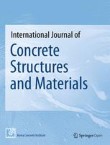International Journal of Concrete Structures and Materials is affiliated with Korea Concrete Institute.
Mechanical Properties of Energy Efficient Concretes Made with Binary, Ternary, and Quaternary Cementitious Blends of Fly Ash, Blast Furnace Slag, and Silica Fume
When the energy performance of concrete is substantially higher than that of normal type concrete, such concrete is regarded as energy efficient concrete (WBSCSD 2009). An experimental study was conducted to inve...
